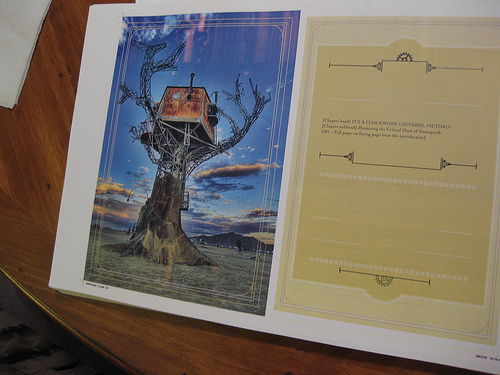After almost a year of researching and writing, this past month S.J. Chambers and I wrapped up our work on The Steampunk Bible, a coffee-table guide to the genre, forthcoming from Abrams Image in May 2011. As we both look back at the process, we remain amazed at how much the book changed and evolved during that time. We began with the goal of providing a definitive overview of the genre in all of its manifestations, while also telling compelling stories about some of its movers and shakers. By September, when we held the first pass in our hands, we were happy to find that true synergy had occurred, and that readers would see the connections and interplay between Steampunk as fiction, fashion, art, making, music, and in other creative disciplines.
The book features quotes or interviews with a wide range of experts, from Libby Bulloff to Ay-leen the Peacemaker, Bruce Sterling to Jake von Slatt, Bryan Talbot to Gail Carringer. It even includes an exclusive excerpt in translation from a Brazilian Steampunk story.
This project was a first for me: my first coffee-table book after five novels, four story collections, and over a dozen anthologies. However, more importantly, this was Chambers’ first book, period. Chambers came to the project with an appreciation for Steampunk art and literature, having spent a lot of time in the 19th century, thanks to her interest in Poe, Austen, the Romantics, and French Symbolism. (All of which added immeasurably to the project.)
As a result, I thought it might be of interest to interview Chambers about her perspective on working on a project that was in many ways new to her in terms of process as well as content.
 S.J. Chambers’s fiction and non-fiction has been published in a variety of publications, including Fantasy, The Baltimore Sun’s Read Street blog, Yankee Pot Roast, Tor.com (where she first aired her Steampunk Poe ideas), and Ann and Jeff VanderMeer’s forthcoming anthology Thackery T. Lambshead’s Cabinet of Curiosities. She is the Articles senior editor at Strange Horizons, a devout Poepathist, a member of the Poe Studies Association, and a regular reviewer for Bookslut.
S.J. Chambers’s fiction and non-fiction has been published in a variety of publications, including Fantasy, The Baltimore Sun’s Read Street blog, Yankee Pot Roast, Tor.com (where she first aired her Steampunk Poe ideas), and Ann and Jeff VanderMeer’s forthcoming anthology Thackery T. Lambshead’s Cabinet of Curiosities. She is the Articles senior editor at Strange Horizons, a devout Poepathist, a member of the Poe Studies Association, and a regular reviewer for Bookslut.
Jeff VanderMeer: In what ways has the process of putting this book together been what you expected, and what has surprised you?
S.J. Chambers: I expected that there would be a lot of research and administrative tasks involved, and I had a good idea of what it would look like simply because the book was growing out of a pre-established aesthetic. But even so, the process was very abstract to me. There are a lot of different aspects to steampunk, and I wasn’t quite sure how they would harmonize visually and textually, so I was really surprised by how at a certain point serendipity seemed to take over and the images and texts informed each other perfectly.
Jeff VanderMeer: How has your idea of steampunk changed while working on the book?
S.J. Chambers: My initial idea of steampunk was that it was an aesthetic movement about nostalgia, but after interviewing people and realizing how fully steampunk spans the globe, I’ve decided it’s really about contemporary dialogue. Steampunk has become an international movement, and is beginning to become popular in countries and cultures that don’t have the Victorian England/Gilded Age American context. These steampunks work within their own cultural heritages to rewrite and explore their histories in an imaginative way without diminishing the seriousness of the issues they raise. In addition to race and class issues, there is also another dialogue on sustainability, consumerism, and community economies. By having all these serious issues raised in an entertaining manner, I think it is more inviting and open to people, and a very effective way of transmitting ideas and information.
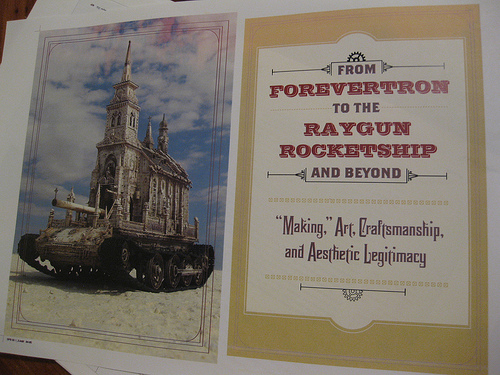
Jeff VanderMeer: What part of working on the book have you most enjoyed?
S.J. Chambers: I really liked doing the research and tracing those figures who influenced steampunk. Because it extends into so many aspects of history: literature, technology, art, fashion, philosophy, and political theory, honing proto-steampunk down to a few figures was really challenging.
Although I enjoyed working on that chapter, I think the most pleasurable chapter for me was the Art and Makers section. I really loved revisiting the Arts and Crafts movement and seeing how much steampunk resonated with it, and I also just loved looking at the images.
Jeff VanderMeer: Do you think steampunk is a cohesive, unified community? What makes it tick?
S.J. Chambers: I think overall, steampunk is really cohesive. I mentioned earlier my idea of it being about dialogue, and I have to admit, that whenever ideas are being discussed, there will be disagreements and arguments, especially when most of it has to take place on the internet. But considering how wide the interests and backgrounds of the various steampunk factions are, I would say overall they are a unified community and the underlying concept that unites them and makes them tick is a common disillusionment with the contemporary world.
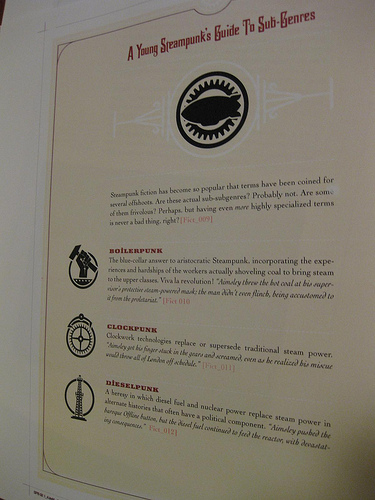 This is stemming more into just my opinion, but the contemporary world (as I know it in the States) is too convenient, and the price one pays for convenience is ignorance and complacence. We don’t understand how things work, and frankly, we’ve become so busy with I don’t know what that it’s just easier to go buy a replacement (which is guaranteed to be more hip and cooler than what broke anyway). And this doesn’t just extend to electronics and mechanics; I’m talking about something as simple as cooking a well-balanced nourishing meal, or mending a ripped hem. The “tick” that synchronizes all of steampunk is the Do-It-Yourself attitude and the appreciation and longing for ingenuity, creativity, and self-reliance that is perceived as being stolen from us everyday thanks to a consumerist culture.
This is stemming more into just my opinion, but the contemporary world (as I know it in the States) is too convenient, and the price one pays for convenience is ignorance and complacence. We don’t understand how things work, and frankly, we’ve become so busy with I don’t know what that it’s just easier to go buy a replacement (which is guaranteed to be more hip and cooler than what broke anyway). And this doesn’t just extend to electronics and mechanics; I’m talking about something as simple as cooking a well-balanced nourishing meal, or mending a ripped hem. The “tick” that synchronizes all of steampunk is the Do-It-Yourself attitude and the appreciation and longing for ingenuity, creativity, and self-reliance that is perceived as being stolen from us everyday thanks to a consumerist culture.
Jeff VanderMeer: Do you have any personal favorites in Steampunk, whether in art, fashion, or literature?
S.J. Chambers: The art has always been what’s appealed to me most about steampunk, and it was how I was first introduced to it in 2007, when a friend drew my attention to the Newsweek article that ran pieces by Datamancer and Jake von Slatt.
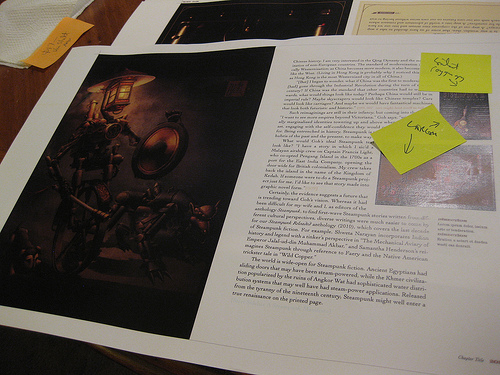
My favorite artists right now are those working in French steampunk. My entire Art History background was involved with 19th century European painting, and from that I focused on late 19th century and early 20th century French movements—Symbolism, Dada, and Surrealism. I see aspects from all three of those movements in the French steampunk artists.
In the work of Vincent Bénard, a.k.a. Futuravapeur, there is the same playfulness and humor used in his comics and sculptures that underlines Dadaism and Surrealism. Sam van Olffen’s paintings have the same brooding and mystic ambiance of Gustave Moreau, but mixed with the psychological associations of Magritte and Dali, paired with the Dadaists obsession with mechanics. I find their work really stimulating, and I’m really excited about watching how it evolves.
Jeff VanderMeer: How has your Poe background influenced your approach to this book?
S.J. Chambers: Since I can remember, I’ve studied Poe and pretty much everything that came through the 19th century in terms of literature and art. I think it gave me a lot of context, especially for the Origins section, where Poe makes an appearance.
Right before we started The Steampunk Bible, I had just wrapped up celebrating Poe’s bicentennial, where I had explored in various articles Poe’s influence on speculative fiction, especially science fiction. I came to the conclusion that Poe’s lesser known science fiction works could be seen as proto-steampunk, which I posted on Tor during the last Steampunk month.
Research for those pieces also led me to revisit a lot of Verne and Wells, as well as the history of natural philosophy and technology, so when The Steampunk Bible came, it was easier to connect the dots—or disconnect them, as was the case sometimes—than if I hadn’t had the context of my previous research.
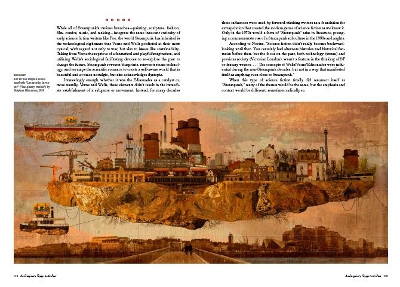
Abrams Image will release the 224-page, full-color Steampunk Bible in May of 2011.
Jeff VanderMeer’s current projects include Finch, Booklife, The Kosher Guide to Imaginary Animals, and Steampunk Reloaded. For more information visit his site and booklifenow.com.










